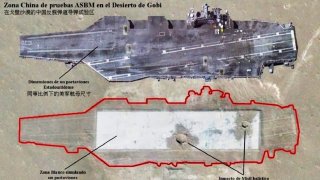DF-26: China's Guam-Killer Missile That Could Sink a Navy Aircraft Carrier
China's People's Liberation Army Rocket Forces (PLARF) possess the DF-26B intermediate-range ballistic missile, known as the "Guam Killer," capable of reaching U.S. facilities on Guam.
Summary: China's People's Liberation Army Rocket Forces (PLARF) possess the DF-26B intermediate-range ballistic missile, known as the "Guam Killer," capable of reaching U.S. facilities on Guam.
-This missile is a critical component of China's strategy to counter U.S. naval power, particularly in scenarios involving Taiwan and the South China Sea. The DF-26B, with its 3,100-mile range and ability to switch between nuclear and conventional payloads, is designed to target moving ships like U.S. aircraft carriers.
-It employs a maneuverable re-entry vehicle (MARV) and potentially an active seeker for final target acquisition, enhancing its accuracy against mobile naval targets.
The DF-26B Makes the U.S. Navy Sweat
Rarely in its history has China been a naval powerhouse. The People’s Liberation Army Navy (PLAN) has extensively modernized its forces and built up its fleet, and the PLAN currently fields more warships than the U.S. Navy. But it is still considered much weaker than its main potential rival, and to better counter U.S. naval forces, China has invested heavily in rocketry and missiles.
Any future conflict between China and the U.S. would most likely be fought over Taiwan, and a major U.S. intervention in this region would see U.S. warships sent to the South China Sea. The PLAN’s ships might not be able to counter the threat, so the PLA Rocket Forces, or PLARF, would step in to contribute.
One of the newest and longest-ranged missiles in the PLARF inventory is the DF-26B. Dubbed the “Guam Killer” because it has the range to hit U.S. facilities on that island, this missile is one of China’s most powerful counters to American naval superiority. And that, of course, means attacking U.S. Navy aircraft carriers in any sort of conflict.
Introducing the DF-26B: The New Aircraft Carrier Killer
The DF-26B is an intermediate-range ballistic missile with a two-stage solid fuel design that gives it a reported range exceeding 3,100 miles.
The warhead cover has a hinge that suggests the ability to rapidly swap out nuclear and conventional payloads.
Over the past two decades, China has consistently upgraded its satellite guidance capabilities. Between 2009 and 2012 alone, Beijing launched several satellites with different sensors, including electro-optical and synthetic aperture radar. These satellites can help with acquisition and tracking of U.S. aircraft carrier battle groups prior to missile launch.
The missile has a maneuverable re-entry vehicle, or MARV, similar to those found on the DF-15, DF-16, and DF-21D missiles. These vehicles have fins that allow them to quickly pull up upon re-entry, glide dozens of miles to the target, and pitch down into a terminal attack angle. The exact accuracy of the system is unknown, but it is estimated to have a circular error of probability of 150-450 meters (other sources do suggest this has improved).
However, taking taking the first measure at face value, this means that if 10 missiles were fired at a target, at least five of them would hit within 150-450 meters of the center.
While these MARVs make the DF-26 highly accurate, the time it takes the projectile to reach a carrier group means the targeted ships will have moved. To account for this, it is assumed that the B variant – specifically designed to attack moving ships – contains an active seeker that helps the missile lock on in its final stages of flight.
Whether this seeker is radar, infrared, electro-optical, or some combination is unknown, but it exponentially increases the lethality of the DF-26B.
Adding to this missile system’s versatility is its road-mobile capability. Each missile can be carried on a transporter erector launcher (TEL) – basically a semi-truck and flatbed that allows for repositioning to set up better shots, or for egress after firing. Current defense estimates count between 250-500 of these TELs in the PLARF inventory.
If the PLARF launches an attack on the island of Guam, forces there might turn to their Patriot and THAAD systems for defense.
About the Author: Maya Carlin
Maya Carlin, National Security Writer with The National Interest, is an analyst with the Center for Security Policy and a former Anna Sobol Levy Fellow at IDC Herzliya in Israel. She has by-lines in many publications, including The National Interest, Jerusalem Post, and Times of Israel. You can follow her on Twitter: @MayaCarlin.
Image Credit: Creative Commons.


